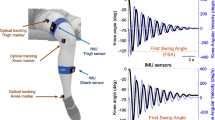Abstract
Purpose
Asymmetric stress imposed on the shoulder can lead to anterior shoulder instability in young athletes who perform repetitive overhead motions. A common treatment, surgical anterior capsule tightening, assumes that the instability is caused by abnormal anterior laxity. This study investigated the possibility that one element of overall imbalance, posterior capsular tightness, could be an underlying reason for shoulder instability. Surgical navigation technology, which is more accurate than whole-body motion-capture systems, was used to study anterior translational motions.
Method
The study was used four cadaver shoulders, with the scapula and rotator cuff muscles intact. Opto-electronic surgical navigation localization devices were mounted on the scapula and humerus to accurately capture positions and orientations. The shoulders were passively moved through 7 motions, 5 of simple angulation and 2 combinations of clinical interest. Each motion was repeated in 4 different soft-tissue states: rotator cuff intact, capsule intact, and surgically induced capsular tightnesses of 5 and 10mm.
Results
The shoulders had significantly greater anterior translation when the posterior capsule was artificially tightened (p < 0.05); this was particularly in movements that combined abduction with internal or external rotation, which are typical overhead sports motions. Overall translation was indifferent to whether the shoulders were intact or dissected down to the capsule, as was translation during flexion was indifferent to dissection state (p > 0.95).
Conclusion
Surgical navigation technology can easily be used to analyze cadaveric shoulder motion, with opportunities for adaptation to anesthetized patients. Results suggest that the inverse of artificial tightening, such as surgical release of the posterior capsule, may be an effective minimally invasive treatment of chronic shoulder dislocation subsequent to sports motions.
Similar content being viewed by others
References
Dunbar MJ, Howard A, Bogoch ER, Parvizi J, Kreder HJ (2009) Orthopaedics in 2020, predictors of musculoskeletal need. J Bone Jt Surg Am 91(9): 2276–2286
Moore SM, Musahl V, McMahon PJ, Debski RE (2004) Multidirectional kinematics of the glenohumeral joint during simulated simple translation tests: impact on clinical diagnoses. J Orthop Res 22(4): 889–894
Bey MJ, Zauel R, Brock SK, Tashman S (2006) Validation of a new model-based tracking technique for measuring three-dimensional, in vivo glenohumeral joint kinematics. J Biomech Eng 128(4): 604–609
Ma B, Ellis RE (2003) Robust registration for computer-integrated orthopedic surgery: laboratory validation and clinical experience. Med Image Anal 7(3): 237–250
Reinold MM, Gill TJ (2010) Current concepts in the evaluation and treatment of the shoulder in overhead-throwing athletes, part 1: physical characteristics and clinical examination. Sports Health 2: 39–50
Burkhart SS, Morgan CD, Kibler WB (2003) The disabled throwing shoulder: spectrum of pathology part I: pathoanatomy and biomechanics. Arthroscopy 19(4): 404–420
Bonnevialle N, Mansat P, Bellumore Y, Mansat M, Bonnevialle P (2009) Selective capsular repair for the treatment of anterior- inferior shoulder instability: Review of seventy-nine shoulders with seven years’ average follow-up. J Should Elbow Surg 18(2): 251–259
Harryman DT II, Sidles JA, Clark JM, McQuade KJ, Gibb TD, Matsen FA III (1990) Translation of the humeral head on the glenoid with passive glenohumeral motion. J Bone Jt Surg Am 72(9): 1334–1343
Hawkins RJ, Angelo RL (1990) Glenohumeral osteoarthrosis: a late complication of the Putti-Platt repair. J Bone Jt Surg Am 72: 1193–1197
Lusardi DA, Wirth MA, Wurtz D, Rockwood CA Jr. (1993) Loss of external rotation following anterior capsuorrhaphy of the shoulder. J Bone Jt Surg Am 75(8): 1185–1192
Samilson RL, Prieto V (1983) Dislocation arthropathy of the shoulder. J Bone Jt Surg Am 65(4): 456–460
DeFranco MJ, Walch G (2011) Current issues in reverse total shoulder arthroplasty: understanding of the inherent limitations and complications is needed. J Musculoskeletal Med 28(3): 85–94
Boileau P, Walch G (1997) The three-dimensional geometry of the proximal humerus. J Bone Jt Surg Br 79(B(5): 857–865
Castagna A, Nordenson U, Garofalo R, Karlsson J (2007) Minor shoulder instability. Arthoscopy 23(2): 211–215
Muraki T, Yamamoto N, Zhao KD, Sperling JW, Steinmann SP, Cofield RH, An KN (2010) Effect of posteroinferior capsule tightness on contact pressure and area beneath the coracoacromial arch during pitching motion. Am J Sports Med 38(3): 600–607
Tyler TF, Nicholas SJ, Roy T, Gleim GW (2000) Quantification of posterior capsule tightness and motion loss in patients with shoulder impingement. Am J Sports Med 28(5): 668–673
Hill AM, Bull AM, Wallace Al, Johnson GR (2008) Qualitative and quantitative descriptions of glenohumeral motion. Gait Posture 27(2): 177–188
Wu G, VanDer Helm FCT, Veeger HEJ et al (2005) ISB recommendation on definitions of joint coordinate systems of various joints for reporting of human joint motion Part II: shoulder, elbow, wrist and hand. J Biomech 38: 981–992
Holloway GB, Schenk T, Williams GB, Ramsey ML et al (2001) Arthroscopic capsular release for the treatment of refractory postoperative or post-fracture shoulder stiffness. J Bone Jt Surg Am 83-A(11): 1682–1687
Author information
Authors and Affiliations
Corresponding author
Rights and permissions
About this article
Cite this article
Zakani, S., Venne, G., Smith, E.J. et al. Analyzing shoulder translation with navigation technology. Int J CARS 7, 853–860 (2012). https://doi.org/10.1007/s11548-012-0782-6
Received:
Accepted:
Published:
Issue Date:
DOI: https://doi.org/10.1007/s11548-012-0782-6




